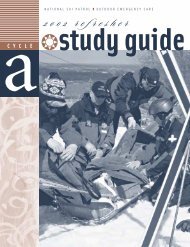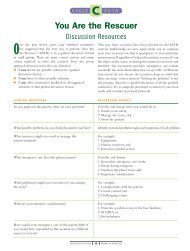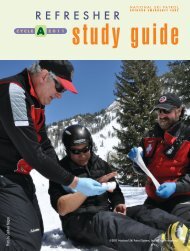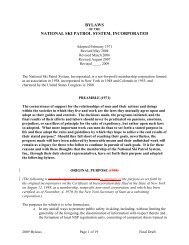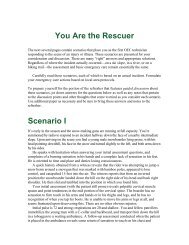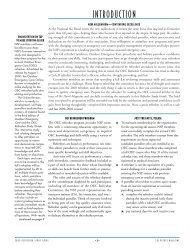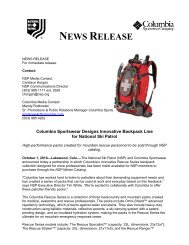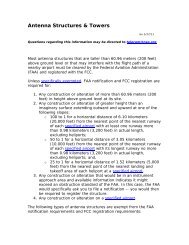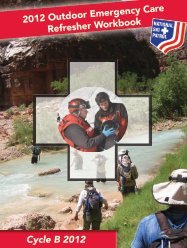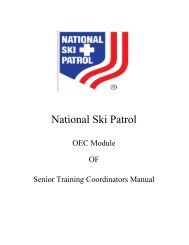Sierra Samaritans - National Ski Patrol
Sierra Samaritans - National Ski Patrol
Sierra Samaritans - National Ski Patrol
Create successful ePaper yourself
Turn your PDF publications into a flip-book with our unique Google optimized e-Paper software.
BY LLOYD MULLER AND<br />
JILL WILLIAMSON<br />
On Solid Ground<br />
One Hour to<br />
Enhanced Balance<br />
SURE, YOU CAN WALK DOWN THE STREET,<br />
up the stairs, or even through a winding<br />
maze of supermarket aisles without falling<br />
over, but that doesn’t mean you have perfect<br />
balance. Years of making those repetitive<br />
movements have trained your body<br />
(as well as your muscles, your vision, and<br />
your inner ear) to remain in equilibrium<br />
even as you move over uneven ground or<br />
stand on one foot. But strap a board or<br />
two to your feet and amp up your velocity<br />
while careening down a steep, snowy pitch<br />
to an incident scene, and your stability<br />
might falter. It happens to the best of us.<br />
<strong>Ski</strong>ing and riding present challenges<br />
that require more precise dynamic balance<br />
than everyday activities do. Our<br />
muscles have to respond faster and absorb<br />
more energy as we move downhill. The<br />
body’s core muscles, namely the abdominals<br />
and those in the lower back, are certainly<br />
key factors in keeping our bodies<br />
stable, but the glutes, hip muscles, hamstrings<br />
and quads give skiers strength,<br />
speed, and power, without which active<br />
balance is impossible.<br />
A year-round workout regimen that<br />
improves basic endurance as well as<br />
strength, flexibility, and balance will greatly<br />
improve your chances of staying upright<br />
on the hill. Here’s a balanced diet of great<br />
exercises you can do in about an hour to<br />
build stamina and stability. (As with any<br />
workout regimen, consult your doctor or<br />
an exercise professional before starting,<br />
and don’t overdo things.)<br />
These exercises will certainly increase<br />
muscle strength, but more importantly<br />
they’ll enhance overall fitness that helps a<br />
body move in balance.<br />
First, it’s important to increase your<br />
endurance by doing some form of sustained<br />
aerobic activity. This will increase<br />
your lung capacity and your heart health<br />
while also working your leg, abdominal,<br />
and lower back muscles.<br />
At the gym, machines such as the<br />
elliptical runner or the stationary bicycle<br />
are great options. They permit lowimpact<br />
activities that spare your joints<br />
from the jarring effects of jumping rope<br />
or running on a treadmill. Such exercise<br />
also helps strengthen the lower body in<br />
preparation for skiing and ’boarding.<br />
To help increase your cardiovascular<br />
conditioning, aim to work out a minimum<br />
of 30 minutes a day, several days a<br />
week. This does not have to be the same<br />
day you do your strength work. On the<br />
day you plan to do strength work, a fiveminute<br />
cardio workout is good to get the<br />
blood flowing throughout the body. This<br />
will help warm up and stretch your muscles,<br />
making your legs more agile and<br />
quick, which is important when carving<br />
tight turns in the trees or navigating a<br />
toboggan down a tough bump field.<br />
snowboarding, you are working your legs<br />
independently by placing more weight on<br />
one leg and then shifting it onto the other.<br />
The following exercises offer fun ways to<br />
“play” and focus on balance. You may find<br />
that one leg does better than the other, and<br />
that’s okay. We recommend doing strength<br />
You might think you have a great sense of balance<br />
and don’t need to work on it. Well, in reality no matter what<br />
you are training for, paying attention to balance is important.<br />
work with one leg at a time to improve and<br />
equalize the strength of each leg.<br />
Think of this portion of the workout<br />
as “getting in touch with the core.” While<br />
the following exercises appear to be aimed<br />
at your legs, you are actually using your<br />
core stabilizer muscles in the back and<br />
abdomen to improve balance.<br />
Sideways Lunge<br />
Start with a centered stance, and extend<br />
the left foot out to the side while both feet<br />
face mostly forward (photo 1). Keeping<br />
your shoulders squared and your chest<br />
LLOYD MULLER<br />
WARM-UP<br />
Before diving headlong into a balance<br />
and strength workout, it’s a good idea to<br />
warm up the muscles by doing slow, gentle<br />
exercises without weights to help get<br />
the blood flowing throughout the body.<br />
BALANCE EXERCISES<br />
You might think you have a great sense of<br />
balance and don’t need to work on it.<br />
Well, in reality no matter what you are<br />
training for, paying attention to balance is<br />
important. Many times while skiing or<br />
photo 1<br />
Sideways Lunge<br />
30 <strong>Ski</strong> <strong>Patrol</strong> Magazine | Winter 2005




